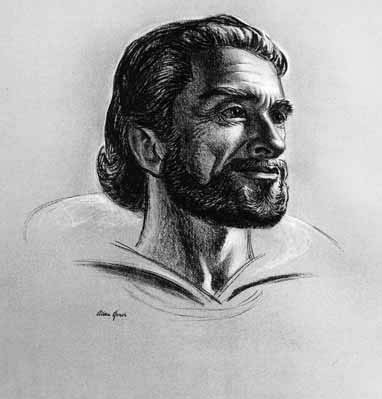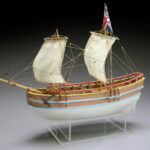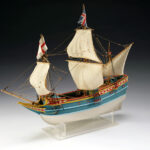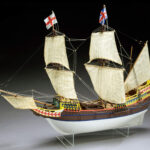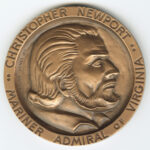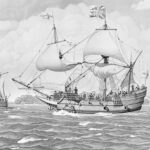Christopher Newport
Explorer
Age of Discovery
Quick Facts:
Privateer and notable explorer most remembered as the leader of the expedition to Virginia in 1606 and the establishment of the Jamestown Colony
Introduction
Christopher Newport, the one armed admiral of Virginia, was a master of the sea. From a young age, Newport spent most of his days out at sea. It would not take long before Newport distinguished himself as a skillful mariner and respectable leader. Whether he was raiding ships as a privateer, conducting trade missions, or transporting colonist to the New World, Newport had a talent for sea voyaging.
Biography
Early Life
Christopher Newport’s date of birth is unknown, but he was baptized at St. Nicolas Church in England on December 29, 1561.1 His father was also named Christopher, and his mother’s name was Jane. But very little else is known of Newport’s childhood. He was not born into nobility, but through a distinguished career he would raise his social status and gain the respect of all his peers. As a young boy, Christopher Newport likely spent his childhood on ships or around them. Newport most likely did receive a formal education, but he could at least read and write. As a young man, Newport gained skills as a mariner through his work as a privateer. Privateers were private ships hired by their government to attack ships of other countries, especially merchant’s vessels. Some people compare privateers to pirates. But unlike pirates who raid for their personal pleasure and gain, privateers are usually hired and paid.
Newport’s reputation grew as a successful privateer. By the age of 29, Newport had earned the rank of Captain.2 In 1590, while fighting two Spanish treasure ships off the coast of Cuba, he lost his right arm during a battle. Despite his loss of hand, Newport was able to continue his maritime career. His most notable privateer victory came in 1592 when he seized the Spanish treasure ship Madre de Dios with nearly half a million pounds of treasure on board. By the year 1606, Christopher Newport had earned a reputation as one the greatest mariners in England. He had much experience sailing along the North American coast and in the Caribbeans. In April 1606, the London based Virginia Company received a charter from King James I giving them exclusive rights to settle the Chesapeake Bay area in the New World.3 Captain Christopher Newport was chosen to command this exciting venture.
Voyages
Principal Voyage
The expedition set sail from London December 19, 1606. Newport captained the flagship Susan Constant. His pilot was none other than famed adventurer and explorer John Smith. They were joined by two cargo vessels – the Godspeed captained by Bartholomew Gosnold; and Discovery captained by John Ratcliffe. There were also around 105 settlers bound for the New World with them. Their goal was to find a suitable place to build a fort and a settlement. Their journey was not easy. They encountered several storms along the way, and the crew were constantly fighting. They sailed to the Caribbean to restock supplies before turning northward to Virginia. They arrived in the Chesapeake Bay area in April 1607. They named the two capes they entered Cape Charles and Cape Henry, after King James’s two sons.4 Upon arriving in Virginia, Newport first landed at Cape Henry but encountered hostile natives.
Looking for a better-protected landing, they sailed upriver, which they named the James River in honor of their king. They went about 30 miles up the James River, and soon found the spot to begin building the fort. On May 13, 1607, they landed and began building their settlement which they named Jamestown, after King James I. After landing, Newport took a small exploration team further up the river. Newport and his men reached a Native American town named Powhatan. Newport erected a cross, and claimed the land in the name of the King of England, and took possession of the land.5 Newport returned to Jamestown briefly. His mission was not to stay, but instead to provide regular supplies to the colony. In June 1607, Newport left Jamestown to sail back to England for fresh supplies.
Subsequent Voyages
Newport would sail to Jamestown three more times to resupply the colony between 1607 and 1608. Jamestown was plagued with problems including famine, disease, harsh winter, and attacks from natives. Almost half of the population had died by Newport’s arrival on January 8, 1608. He brought fresh supplies and about 120 new colonists to the settlement. A few days later, nearly the entire settlement had caught fire and burned down. Over the next few months, Newport and Smith negotiated with the Powhatan natives for food to help get them through winter. It was not long after that Newport and some of the colonists found what they thought was gold near Jamestown. On April 10, 1608, Newport headed back to England with his ships filled with “gold.” When he arrived in England in May, he found out that the “gold” he found was actually iron pyrite – commonly known as fool’s gold. Newport was back in Jamestown in September 1608. He brought new supplies and colonists, including the first two women in the colony.6 He visited chief Powhatan at his capital Werowocomoco. Newport had been instructed to have the Indian chief recognize the authority of King James I. He resisted at first. But eventually Powhatan went through the recognition ceremony. He received gifts from the British, and in turn presented his own gifts.7
Newport was back in England by January 1609. He was only there a few months though before he was back at sea. In need of help, Newport sailed with a large fleet of nine ships to resupply and bring new settlers to Jamestown. This journey would be a dangerous one for Newport and his fleet. Newport set sail from England on June 2, 1609, aboard the flagship Sea Venture. Packed tight with settlers and supplies the nine ships set out to save the falling colony. They encountered several storms along the way. But a hurricane on July 24, 1609 separated the Sea Venture from the rest of the fleet. The ship was severely damaged, and they soon ran aground on some rocks off the island of present day Bermuda. The crew were able to salvage much of the ship. Newport and the men and women aboard the Sea Venture were stranded on Bermuda for almost a year. They hunted animals such as boar, fished, and built housing structures from the palmetto trees on the island.8 The survivors were able to build two small vessels using wood from local trees and salvaged pieces of the Sea Venture wreck. But instead of a thriving settlement, Jamestown had only a small number if survivors and many of the buildings were gone. The winter of 1609-1610 was known as the “starving time,” and it crippled the Jamestown colony. Newport stayed for several several months as they rebuilt much of the settlement. He set sail for England in September 1610.
Later Years and Death
Christopher Newport made one more trip to Jamestown in the spring of 1611. He once again resupplied the colony, stayed for several months, and returned to England by October. He continued to sail for the Virginia Company until 1612. After which he was appointed one of the six masters of the Royal Navy and began to work for the East India Trading Company.9 Newport continued his sailing career carrying diplomats and conducting trade missions. On his third and final voyage for the company, he arrived at the island Java on August 15, 1617. Christopher Newport died not long after from causes unknown.
Legacy
Christopher Newport had a long and distinguished career at sea. He led the expedition to found the Jamestown Colony, the first permanent British settlement in North America. He also helped keep the struggling settlement alive with fresh supplies and new settlers. The storm and shipwreck on the island of Bermuda is said to have inspired William Shakespeare’s great play The Tempest.10 He continued his life at sea up until his death on his final voyage. His name lives on in several places in Virginia. The city of Newport News and Christopher Newport University within the city both bear his name.
Images
- Model of the merchant vessel, “Discovery,” one of 3 ships to arrive in Jamestown in 1607. The Mariners’ Museum 1957.0004.000001
- Model of the merchant vessel, “Godspeed,” one of 3 ships to first arrive in Jamestown in 1607. The Mariners’ Museum 1957.0003.000001
- Model Christopher Newport’s flagship, “Susan Constant,” one of 3 ships to first arrive in Jamestown in 1607. The Mariners’ Museum 1951.0004.000001
- Medal showing Christopher Newport. The Mariners’ Museum 1971.0062.000001
- Christopher Newport’s flagship, “Susan Constant,” with “Godspeed” and “Discovery” in background arriving in Jamestown in 1607. The Mariners’ Collection 1949.0004.000003
Endnotes
- Allen Bryant Nichols, Captain Christopher Newport: Admiral of Virginia (New York: St. Martin’s Press, 2007), 4.
- Nichols, Captain Christopher Newport, 2.
- John Huxtable Elliott, Empires of the Atlantic World: Britain and Spain in America, 1492-1830 (New Haven: Yale University Press, 2006), 16.
- Benson John Lossing and Woodrow Wilson, Harper’s Encyclopedia of United States History from 458 A. D. to 1909, Volume 9 (New York: Harper & Brothers Publishers, 1906), 542.
- Elliott, Empires of the Atlantic World, 10.
- Lossing and Wilson, Harper’s Encyclopedia, 542.
- Elliott, Empires of the Atlantic World, 14-15.
- Virginia Bernhard, A Tale of Two Colonies: What Really Happened in Virginia and Bermuda? (Columbia, MO: University of Missouri Press, 2011), 72-73.
- Lyon Gardiner Tyler, ed., Encyclopedia of Virginia Biography, Under the Editorial Supervision of Lyon Gardiner Tyler, Volume 1 (New York: Lewis Historical Publishing Company, 1915), 76.
- Karen Ordahl Kupperman, The Jamestown Project (Cambridge, MA: The Belknap Press of Harvard University Press, 2007), 139.

